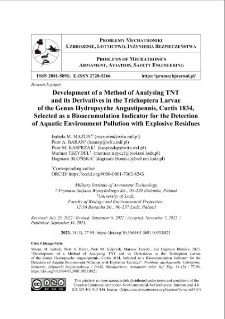Our Digital Library contains 1 868 digital objects
Object
Title: Development of a Method of Analysing TNT and its Derivatives in the Trichoptera Larvae of the Genus Hydropsyche Angustipennis, Curtis 1834, Selected as a Bioaccumulation Indicator for the Detection of Aquatic Environment Pollution with Explosive Residues
Alternative title:
Contributor:
Piotr A. BARAN, Piotr M. KASPRZAK, Mariusz TSZYDEL, Dagmara BŁOŃSKA
Abstract:
Threats associated with the production, storage and use of warfare agents containing high explosives against the backdrop of political and social events emerging in the 21st century present new challenges for specialized laboratories involved in detecting contamination and identifying its source. A common analytical problem in studies conducted in the ecosystem is the low concentration of the test substance – below the detection limit of the instrument. Helpful in solving this dilemma are accumulation bio-markers, which appear to be an excellent tool for detecting contamination in, for example, flowing water. Such biomarkers make it possible to determine the presence of specific chemical agents at the same time they are a sensitive indicator of the ecosystem's response to contamination. The presented chromatographic method allows quantitative and qualitative determination of 2,6-diamino-4-nitrotoluene, 2,4-diamino-6- nitrotoluene, 1,3,5-trinitrobenzene, trinitrotoluene, 2-amino-4,6-dinitrotoluene, 4-amino-2,6-dinitrotoluene and tetryl in the biological matrix. The effects of accumulation in the tissue of crustaceans on TNT test solutions were studied from 1 to 24 hours. The saturation effect was observed and the concentration of TNT derivatives was measured. The observed effects confirmed the usefulness of the selected larva as a bio-indicator of TNT contaminant accumulation in the ecosystem.
Place of publishing:
Warszawa
Publisher:
Date created:
Date submitted:
Date accepted:
Date issued:
Extent:
Identifier:
oai:ribes-88.man.poznan.pl:2682
Call number:
Electronic ISSN:
Print ISSN:
Language:
License:
Rights holder:
Starting page:
Ending page:
Volume:
Journal:
Keywords:
security, contamination, HPLC, TNT, bio-indicator
Object collections:
Last modified:
Oct 15, 2025
In our library since:
Oct 15, 2025
Number of object content hits:
0
All available object's versions:
https://ribes-88.man.poznan.pl/publication/3015

